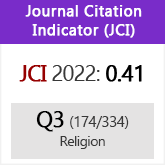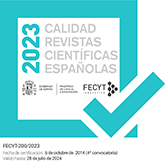Un estudio sobre el color: los usos de לָבָן en la Biblia hebrea
DOI:
https://doi.org/10.3989/sefarad.017.002Palabras clave:
Hebreo Bíblico, texto masorético, blanco, cromatismo, lenguas semíticas, contexto extraverbal, simbolismoResumen
El estudio del color permite asumir la correlación (y no correlación) entre elementos psicológicos, sociales, simbólicos y el lenguaje en sí. Y la Biblia Hebrea no es una excepción. Considerando la magnitud de este proyecto, este artículo refleja la primera etapa de mi estudio sobre los colores en el texto masorético, específicamente en לָבָן, término traducido habitualmente como ‘blanco’, así como las diferentes formas verbales que contienen la raíz לבן. Si se compara לָבָן con el resto de términos de color, se llegará a la conclusión de que este es el más común de todos, haciendo que sea considerado un término primario y bien documentado. Pero dicha antigüedad es prueba de su opacidad. Una lectura detallada de לָבָן refuerza la idea de que la traducción de este término como ‘blanco’ es incompleta. De hecho se refiere a algo cuyo cromatismo es bajo pero brillante al mismo tiempo. Esta “vaga naturaleza” es lo que hace que לָבָן esté tan presente en la Biblia Hebrea. Este artículo tiene como objetivo mostrar la percepción cromática de לָבָן.
Descargas
Citas
Adler, Cyrus and Isidore Singer (1901-1906): Jewish Encyclopedia (New York – London: Funk & Wagnalls Company [http://www.jewishencyclopedia.com/]).
Banti, Giorgio and Riccardo Contini (1997): "Names of Aromata in Semitic and Cushitic Languages," in Alessandra Avanzini (ed.), Profumi d'Arabia (Roma: "L'Erma di Bretschneider) pp. 169-192.
Brenner, Athalya (1982): Colour Terms in the Old Testament (Sheffield: The University of Sheffield Department of Biblical Studies).
Brothwell, Don and Patricia Brothwell (1969): Food in Antiquity: A Survey of the Diet of Early Peoples (Baltimore – London: The John Hopkins University Press).
Brown, Francis, Samuel Rolles Driver and Charles Augustus Briggs (1906): A Hebrew and English Lexicon of the Old Testament with an Appendix Containing the Biblical Aramaic (BDB) (Cambridge: Riverside Press).
Bulakh, Maria (2004): "Color Terms of Modern South Arabian Languages: A Diachronic Approach," in L. Kogan, N. Koslova, S. Loesov and S. Tishchenko (eds.), Babel und Bibel 1: Annual of Ancient Near Eastern, Old Testament, and Semitic Studies (Indiana: Eisenbrauns) pp. 269-282.
Bulakh, Maria (2006): "Basic Color Terms of Biblical Hebrew in Diachronic Aspect," in L. Kogan, N. Koslova, S. Loesov and S. Tishchenko (eds.), Babel und Bibel 3. Annual of Ancient Near Eastern, Old Testament, and Semitic Studies (Indiana: Eisenbrauns) pp. 181-216.
Cambridge Dictionary, Cambridge Free English Dictionary and Thesaurus [http://dictionary.cambridge.org/].
Cantera Burgos, Francisco and Manuel Iglesias González, (eds.) (2009): Sagrada Biblia (Madrid: Biblioteca de Autores Cristianos).
Charles, Robert Henry (ed.) (1920): A Critical and Exegetical Commentary on the Revelation of St. John, 2 (Edinburgh: ICC).
Chase, Mark W. (2009): "An Update of the Angiosperm Phylogeny Group Classification for the Orders and Families of Flowering Plants: APG III," in Michael F. Fay (ed.), Botanical Journal of Linnean Society 161:2 (London: Biological Journal of the Linnean Society) pp. 105-121.
Colomina, Merce, Francisco Enrique Moltó (2011): Susana Cortés and Vicente Giner, "Marjolin's Ulcer in a Patient with Residual Hansen's Disease," in Benito Almirante Gracera Enfermedades Infecciosas y Microbiología Clínica 29.
Duke, James A., Peggy-Ann K. Duke and Judith L. du Cellier (2008): Duke's Handbook of Medicinal Plants of the Bible (Boca Raton, FL: CRC Press). https://doi.org/10.1201/9781420043174
Felipe, Antonio J., Rafael Socias i Company and Joaquín Gómez Aparisi (1988): "The Almond Rootstock Ideotype," in Antonio J. Felipe (ed.), Acta Horticulturae 470 (1988) pp. 181-187.
Freedman, David Noel (gen. ed.) (2000): Eerdmans Dictionary of the Bible (Michigan: Eerdmans [accordance electronic edition, version 3.6]).
García Ureña, Lourdes (2015): "Colour Adjectives in the New Testament," in Francis Watson (ed.), New Testament Studies 61(Durham: Abbey House) pp. 219-238.
García Valdés, Manuela (ed.) (1998): Dioscórides: Plantas y remedios medicinales. De materia médica. Libros I-III (Madrid: Editorial Gredos).
Gradwohl, Roland (1963): Die Farben in Alten Testament: Eine Terminologische Studie (Berlin: Walter de Gruyter).
Guillaumont, Antoine (1957): "La designation des couleurs en Hebreu et Arameen," in Ignace Meyerson (ed.) Problèmes de la couleur (Paris: S.E.V.P.E.N.) pp. 339-348.
Hartley, John E. (2010): The Semantics of Ancient Hebrew Colour Lexemes (Leuven: Peeters).
Hulse, E. V. (1975): "The Nature of Biblical 'Leprosy' and the Use of Alternative Medical Terms in Modern Translations of the Bible," in Palestine Exploration Quarterly 107:2 (Taylor & Francis Group) pp. 87-105. PMid:11623463
Keil, Carl Friedrich and Franz Delitzsch (1865): Biblical Commentary on the Old Testament, I (Edinburgh: Clark's Foreign Theological Library).
Lyons, John (1999): "The Vocabulary of Color with Particular Reference to Ancient Greek and Classical Latin," in Alexander Borg (ed.), The Language of Color in the Mediterranean: an Anthology on Linguistic and Ethnographic Aspects of Color Terms (Stockholm: Almqvist & Wiksell International) pp. 38-75.
Mateos, Juan (1989): Método de análisis semántico: aplicado al griego del Nuevo Testamento (Córdoba: El Almendro). PMCid:PMC1003906
Müller, Walter (1974): "Zur Herkfunt von λίβανος und λίβανωτός," in Glotta 52, pp. 53-59.
Müller, Walter (1978): Weihrauch. Ein arabisches Produkt und seine Bedeutung in der Antike (Munich).
NIAMS (National Institute of Arthritis and Musculoskeletal and Skin Diseases, 2014) "¿Qué es el vitiligo?" [https://www.niams.nih.gov/Portal_en_espanol/Informacion_de_salud/Vitiligo/default.asp].
Noegel, Scott B. (1997): "Sex, Sticks and the Trickster in Gen. 30: 31-43: A New Look at an Old Crux," in Journal of Ancient Near Eastern Society 25, pp. 7-17.
Preuss, Julius and Fred Rosner (1978): Biblical and Talmudic Medicine (New York: Hebrew Publishing Company). PMCid:PMC2595735
Pulos, William L. and Frederick B. Hutt (1969): "Lethal Dominant White in Horses," in J. Hered (ed.), The Journal of Heredity 60:2 (Oxford 1969) pp. 59-63. https://doi.org/10.1093/oxfordjournals.jhered.a107933
Raymond E. Brown, Joseph A. Fitzmeyer and Roland E. Murphy, Comentario Bíblico "San Jerónimo." Tomo I. Antiguo Testamento I (Madrid: Ediciones Cristiandad, 1971).
Real Academia Española, Diccionario de la lengua española (23.a ed. [http://www.rae.es/]).
Ribera-Florit, Josep (2005): Guía para el estudio del Arameo Bíblico (Madrid: Sociedad Bíblica).
Rosner, Fred (2000): Encyclopedia of Medicine in the Bible and the Talmud (Nothvale – New Jersey – Jerusalem: Jason Aronson).
Ryken, Leland, James C. Willhoit and Tremper Longman III (eds.) (1998): Dictionary of Biblical Imaginery (Downers Grove, IL: InterVarsity Press). PMid:17154441
Segura Munguía, Santiago and Javier Torres Ripa (2011): Las plantas en la Biblia (Bilbao: Universidad de Deusto – Madrid: Consejo Superior de Investigaciones Científicas).
Setia, Maninder Singh, Craig Steinmaus, Christine S. Ho and George W. Rutherford (2006): "The Role of BCG in Prevention of Leprosy: A Meta-analysis," in Salvatore Pablo Lucia (ed.), Lancet Infect Dis. 6:3, pp. 162-170. https://doi.org/10.1016/S1473-3099(06)70412-1
Sima, Alexander (2000): Tiere, Pflanzen, Steine und Metalle in den altsüdarabischen Inschriften (Wiesbaden).
Skinner, John (1910): The International Critical Commentary. A Critical and Exegetical Commentary on Genesis (New York: Charles Scribner's sons) p. 392.
Souvay, Charles (1907): "Animals in the Bible," in Kevin Knight (ed.),The Catholic Encyclopedia (New York: Robert Appleton Company [http://www.newadvent.org/cathen/01517a.htm]).
Strong, James (1890): The Exhaustive Concordance of the Bible (Cincinnati: Jennings & Graham [accordance electronic edition, version 3.6]).
UCSB ScienceLine. 2015. "Why is milk white?," University of California [http://scienceline.ucsb.edu/getkey.php?key=3227].
Veterinary Genetics Laboratory, "Introduction to Coat Color Genetics," in School of Veterinary Medicine, University of California, Davis (2008 [https://www.vgl.ucdavis.edu/services/coatcolor.php]).
Wood, D. R. W., A. R. Millard, J. I. Packer, D. J. Wiseman and I. Howard Marshall, (eds.) (1996): New Bible Dictionary (Downers Grove, IL: InterVarsity Press [accordance electronic edition, version 3.6]).
Zohary, Michael (1982): Plants of the Bible (Cambridge: Cambridge University Press). PMid:24270617
Descargas
Publicado
Cómo citar
Número
Sección
Licencia
Derechos de autor 2017 Consejo Superior de Investigaciones Científicas (CSIC)

Esta obra está bajo una licencia internacional Creative Commons Atribución 4.0.
© CSIC. Los originales publicados en las ediciones impresa y electrónica de esta Revista son propiedad del Consejo Superior de Investigaciones Científicas, siendo necesario citar la procedencia en cualquier reproducción parcial o total.Salvo indicación contraria, todos los contenidos de la edición electrónica se distribuyen bajo una licencia de uso y distribución “Creative Commons Reconocimiento 4.0 Internacional ” (CC BY 4.0). Puede consultar desde aquí la versión informativa y el texto legal de la licencia. Esta circunstancia ha de hacerse constar expresamente de esta forma cuando sea necesario.
No se autoriza el depósito en repositorios, páginas web personales o similares de cualquier otra versión distinta a la publicada por el editor.














